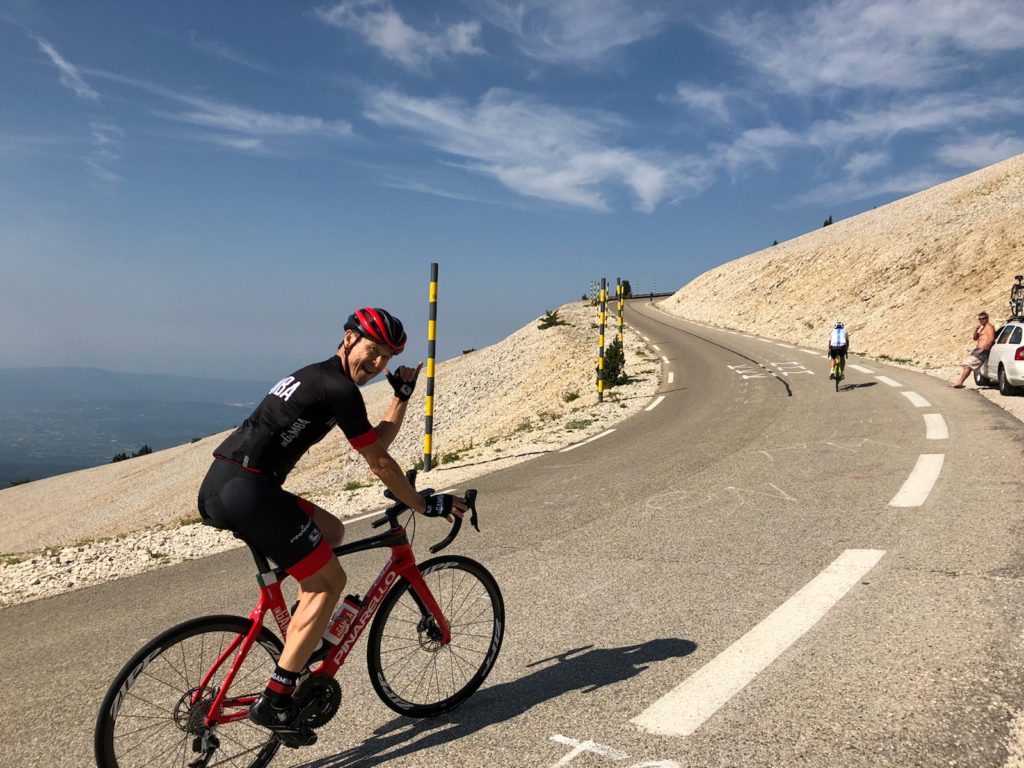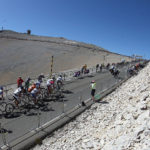
By Ron Berry, PHASE IV Director of Rehabilitation
Part 1: 3 Months to Mont Ventoux
Part 2: 2 Months to Mont Ventoux
Part 3: 3 Weeks to Mont Ventoux

Travel to Mont Ventoux: Part 4
Managing jet lag on long trips
When we travel far away it is such a shame to find ourselves suffering from jet lag. When it comes to adventurous trips, we want to be able to get right into the excitement and action upon arrival, so missing an entire day of one’s trip due to exhaustion can be so annoying. A trip to Europe can benefit from some preparation adjustments to sleep patterns. Not that this is always possible for everybody in our busy lives but whatever we can do to mitigate jet lag can make our adventure that much better.
SLEEP TECHNIQUES TO REDUCE JETLAG
For my recent week long bicycle tour in Provence, France I prepared by going to bed two hours earlier than normal and waking up three hours earlier the few days before my trip. The week before my trip was also the final week of the Tour de France so waking up earlier worked out well for me as I got to watch the bicycle races live while pedaling on my bicycle trainer at low intensity for an hour. This activity served several purposes including keeping my legs fit and capable in my taper week before my bicycle tour, and also getting my body used to being awake at 4am.
Another benefit was that I was tired in the afternoon from waking up early so it was easier for me to take an hour-long nap and get used to falling asleep at European bedtime. A little adjustment to my work schedule really wasn’t that difficult. After my hour long riding session on the trainer I was able to sit at the desk and do a little work. This allowed me to have more time after lunch so I could sleep a full hour, although it took a few minutes to wake up without caffeine. However, those few minutes of being groggy were being traded for less time being groggy once I arrived in France.
On travel day, I made an effort to sleep during French sleep time and also limited my caffeine and alcohol use to when I normally would partake on French time. Throughout the day when I checked the time I looked at the time at my destination which was helping my brain adjust to European time.
AVOIDING ACHES AND PAINS ON A LONG FLIGHT
I avoided sitting while waiting in the airport terminal. I would be doing plenty of sitting in the plane so why sit when I could stand? It’s good to keep the stresses on my body varying.
When I was booking my trip I valued the cost savings of an economy seat. I had to balance my trip costs with having higher quality accommodations and a higher quality tour company once I got to France. However, because I had limited personal space to stretch out, I had to do what I could to stay loose and comfortable and avoid aches and pains that often result from sitting for too long on a 14-hour plane ride.
I made an effort to not sit in any slouched posture as that can easily lead to spinal muscles and discs becoming irritated. I traveled with a small Thermarest inflatable pillow that I used at times behind my lumbar spine to support my curve, and, occasionally, underneath me in the back part of the seat to change the weight bearing pressure on my bottom.
Another choice I made was to have a 90-minute layover on the East coast so I could walk around and also sync up my longest sleep period on French time while flying over the ocean.
EASY STRETCHES TO DO ANYWHERE
Hip flexors
There are several stretches that are easy to do while waiting at the airport or in the aisle of the plane. Muscles that have to be stuck in the same position for a long time are more likely to be achy and unhappy. The hamstrings and hip flexors are two of the most victimized by long bouts of sitting. The hip flexors can be stretched by going down onto one knee in a lunge position then moving the hips forward while keeping the torso upright. This lengthens the front of the hip that you are kneeling on in the opposite position of sitting. Be cautious that the kneecap is not on too hard a surface and that the front foot is far enough in front so that the front knee doesn’t go past the toes. This will protect the patellar tendon.
Hamstrings
To stretch the hamstring of the front leg from this position, move your hips back and straighten your front leg while keeping your torso upright.
Back / Spine
Another simple move to do to keep the stress off the back by being flexed forward from sitting too much is to stand and put your hands on the back of your pelvis and lean your upper spine and shoulders backwards about half of what you can do comfortably. Hold for a second then return to vertical and repeat 5-10 times. Again, the opposite of sitting for the spine and a good way to change the position and length of the lumbar muscles, as well as, change the pressure on our vulnerable lumbar discs.
If the spine feels especially compressed from sitting too long there are ways to counteract that. One is to put your hands on the arm rests of the seat then straighten your elbows while your feet are on the floor so that your buttocks are in the air. From this position let your spine relax and have the compressive pressure be relieved. If you’re too tall or don’t want to put as much stress on your arms, you can put your hands on your lap as close to the hips as possible then lift your chest up and push down on your lap. This can create a similar relief as having your hands on the arm rests.
Knees
If your knees tend to be stiff upon rising from extended sitting, it is wise to avoid sitting with your knees bent more than 90°. This position puts pressure underneath the kneecap and could impact the lymph nodes in the back of the knee from reducing any swelling. Also, intermittently making big circles with your feet keeps the circulation and joints moving in your lower legs.
HYDRATION
To counteract jet lag a very common adage is to drink more water. A hydrated body is critical for so many systems of the body. The inside of the airplane is pressurized so that the atmosphere is similar to being at 4,000 feet. Since this is more altitude than what most of us live at the benefit of hydrating is similar to that of hydrating when we are up the mountains. Also, if you are drinking more water you probably have to pee more so this will force you to get up and move a little more.
COUNTERACTING LEG SWELLING
If we are moving more it is less likely to have swelling occur in the lower legs, a common problem with, long flights. When traveling I always wear my knee high EC3 compression stockings, which clearly reduces the mild swelling around my feet and ankles when flying. These are some of the steps we can take to reduce the effects of a long travel day on our body.
EXERCISE
Another common adage to reduce the effects of jet lag is to get a workout in soon after you arrive to your destination. This brings us back to my recent bicycle trip to Provence with the touring company InGamba. The first afternoon we got together, the mechanic had the bikes we would be using set up to our measurements. The first ride wasn’t overly challenging – 41 km over rolling hills – but it was enough that I had some sense of fatigue. That, followed by a delicious salad of locally farmed Provence fruits and vegetables and salmon, led to me falling asleep quickly, at a normal French bedtime.
The next morning the meeting time was 7:15 am France time (10:15 pm California time). We had a light breakfast of yogurt, croissants, fruit, and coffee. Then we were onto our bikes by 8am. Twenty two hours after I arrived in Europe, we rolled through a beautiful ride of 80km (50 miles) with 1,344 meters (4,400 feet) of climbing, and I felt great. Whether it was my joy of embarking on a great holiday, or riding a top of the line Pinerello bicycle, or all of my efforts to avoid jet lag, I felt no effects of jet lag nor pain from sitting in an economy seat for 14 hours. It was a great feeling to have at the start of an active vacation.
IN SUMMARY:
- Begin adjusting sleep and wake times a week before travel to reflect those of the place you are traveling to
- Stay mobile much as possible at the airport and on the plane when awake
- Practice the appropriate stretching exercises several times throughout travel day to avoid aches, pains and stiff joints
- Wear compression stockings, walk around and keep knees bent less that 90 degrees on the plane to avoid leg swelling
- Stay hydrated throughout travel, but especially on the plane
- Exercise the day you arrive at your destination if early enough
COMING UP…
In the next installment of this column, read about how Phase IV science, and Ron’s 3-Month training plan, helped him in his week of bicycling in Provence and his culminating ascent of the legendary Mt. Ventoux. If you are planning a long trip soon and are concerned about the effects of traveling on a vulnerable body part or want to learn more about strategies to avoid jet lag please contact us at ron@phase-iv.net. If you are interested in learning more about high quality bicycle tours please contact InGamba.pro.
If you are planning a long trip soon and are concerned about the effects of traveling on a vulnerable body part or want to learn more about strategies to avoid jet lag please contact Ron Berry at ron@phase-iv.net. If you are interested in learning more about high quality bicycle tours please contact InGamba.pro.








